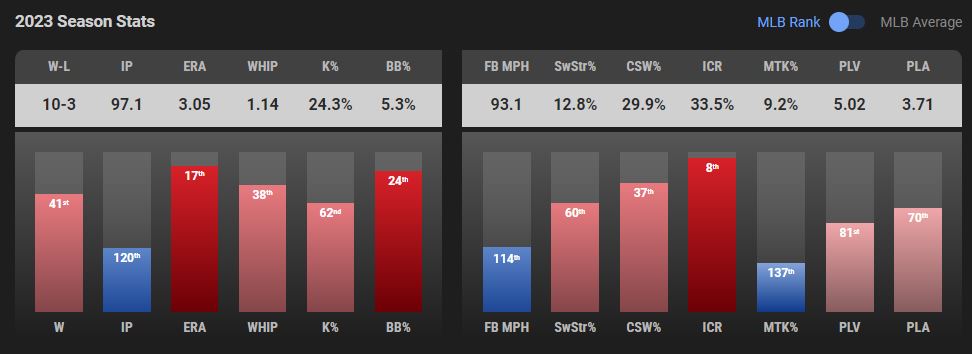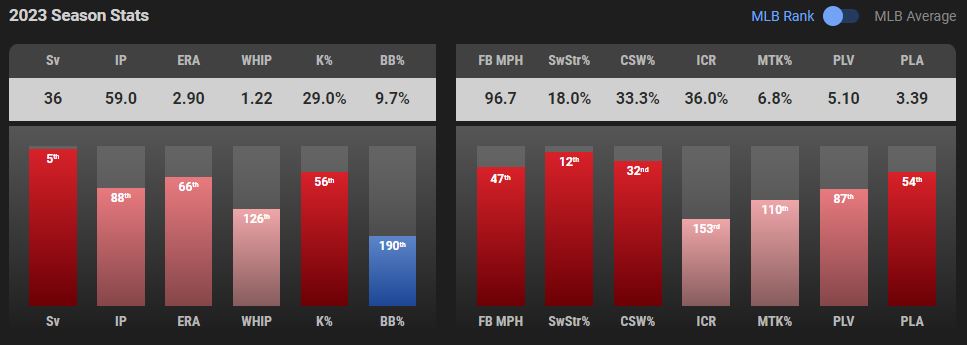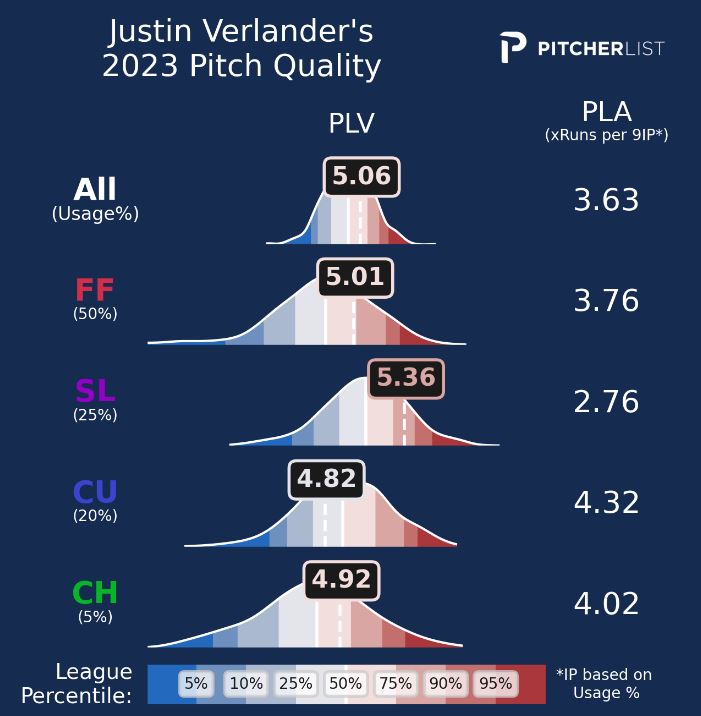It’s often said that throwing a baseball is an unnatural motion. If you’ve ever watched a frame-by-frame breakdown of a pitcher’s wind-up, you would see how their forearm goes through a violent, 180-degree rotation just before the release point. It’s honestly hard to watch and you’re left wondering how any pitcher really can stay healthy.
As pitchers throw harder from season to season, the stress on the arm goes up. Injuries of all types, but especially the dreaded Tommy John, have exploded for pitchers in the last 20 years. Among Statcast’s 64 highest-velocity pitchers, 30 have gotten TJS – some of them twice.
So it turns out that chucking a five-ounce sphere almost a hundred miles an hour over and over again is pretty terrible on your body. This is the biggest reason why innings are being managed so carefully, and more and more pitchers are topping out at 150 innings per season instead of the 200-220 innings workhorses we used to see.
When evaluating pitchers coming off of injuries, here are a few questions you want to ask:
- Is it an arm or shoulder injury, or something else? Recovering from an arm injury is slow and painful, whether from a surgical procedure or not. When your pitcher is finally cleared to throw again, it’ll be six to eight weeks before they’re game-ready.
- Has their recovery been without setbacks? Any rehab from a major injury is sure to have its ups and downs, but were there any recurrences that reset their timeline, or have they progressed according to the original prognosis?
- Was the injury a one-time event or something that wore down over time? Usually the freak incident – like dropping a weight on your toe – has a clearer path to recovery.
- And finally, the eye test. Now that they’re back on a mound, how are they looking? Is there any wincing or laboring?
Don’t put too much stock in the actual results – obviously, it’s better if they’re striking out everyone, but your pitcher will likely be rusty after a long rehab. For instance, last year Tarik Skubal gave up seven earned runs in his third start back from flexor tendon surgery. Luckily these pitchers below will be ramping up in spring training and can shake out the rust when the games don’t matter.
So that said, here are five pitchers who are primed for bounce-back seasons.
Diaz broke the heart of the collective baseball universe when tearing his patellar tendon after a Puerto Rico victory in the WBC, missing the entire MLB season. Now in camp and with the team saying he’s ‘fully healthy’, Diaz is taking fielding drills and again hitting triple-digits on the radar gun.
Diaz threw a live batting practice on February 27 and will do so again this week in what might be his last tune-up before entering a spring training game. This ramp-up might seem slow but Diaz should be able to squeeze in several relief appearances ahead of Opening Day.
Let’s just throw a few numbers out there from Diaz’s 2022 season, which may have been the best of any closer in our lifetime: 1.31 ERA, 17.1 strikeouts-per-nine, .158 batting average against, and a 0.88 WHIP. The fact that he only got 32 saves in 61 appearances that year feels like a crime, but the Mets are the Mets.
Diaz is a two-pitch pitcher with just a fastball and a slider, throwing the latter almost 60% of the time. These are his slider numbers, and yes I double-checked them for typos:
| Strike % | SwStr% | CSW% | PLV | BAA |
| 71.6% | 31.7% | 45.6% | 5.42 | .114 |
I mentioned this in my Injury Round-up but this injury was Diaz’s first appearance on the IL in his career, so once deemed set to go he should be as reliable as anyone. So going by the checklist detailed in the intro, he’s three for three and all that’s left is the eye test.
Diaz was far and away the most dominant closer in 2022 and there is no reason to think he can’t be that player again this year. He is currently going in the same tier as Devin Williams and Josh Hader but his upside is so much more, and if he has another season like ’22 he should have more than 32 saves (but again, the Mets will Met). The only question is whether you want a relief pitcher in your top 50 players drafted – for most of us the answer will be no, but if you’re a yes this is the one you want.
Remember August of 2022? Somehow it feels like a lifetime ago, but this is when the Yankees acquired Montas at the trade deadline to fuel what they hoped would be a run to the World Series. Though Aaron Judge was still hitting bombs that summer, the newly-acquired Montas started dropping them – earning a 1.54 WHIP and 6.53 ERA with New York.
Somehow, 2023 was worse – Montas underwent arthroscopic shoulder surgery in February and was originally expected to miss three months. But setbacks kept delaying his timeline and he ended up making only a couple of token relief appearances at the end of another lost Yankees season.
The Reds are taking a $16 million gamble on Montas this year, but it’s a one-year, let’s-see-what-you’ve-got type of contract. So far, they seem thrilled with the early returns: Montas has looked sharp throughout camp and turned in two innings of no-run, no-hit ball in his spring training debut against the Cubs. His second outing had some mistakes, but he still has a few weeks to iron those out.
For some players, the Yankee pinstripes can be imprisoning, and that may have been the case with Montas. Moving to the Reds – a young, vibrant clubhouse with irreverent swagger – should help him find his mojo. After all, Montas is only a few years removed from 2021 when he topped 200 strikeouts pitching for the A’s, then and now the worst team in baseball.
Montas is going outside the top 300 in the NFBC, drafted around the same area as Jameson Taillon and Sean Manaea. Some might have concerns that he’s moving to a hitter’s park, but as long as he’s mixing his splitter and sinker equally with his fastball, he can keep his ground-ball rate up close to 50% and keep the home runs down. As long as his shoulder holds up and the Reds don’t cap his innings, Montas has the potential to be a top-40 starter.
Musgrove got off to a late start in 2023 thanks to a fractured toe (the aforementioned weight-dropped-on-foot), and once on the mound, it took a while to get going. But he found his groove in the summer and won eight games in June and July. That all got derailed, however, once shoulder inflammation forced Musgrove to shut down. The initial prognostication was three weeks of rest, but that timeline never panned out and his season was over.
Now six months later, Musgrove has already appeared in two spring training games. The results have been less than impressive, though, as he was unable to get out of the first innings in either outing.
Going back to our checklist, this shouldn’t be too worrisome. Musgrove is also known to tinker in the spring and carries a 6.00 career ERA when games don’t count. He’s currently attempting to work a sweeper into his arsenal and polishing the shape and location of his other off-speed dealings.
It also should be noted that after getting pulled in the first inning of his last outing, he returned in the second and retired the side in 11 pitches.

Though not the hardest thrower, Musgrove pitches to weak contact and still gets decent K’s
Though he didn’t top 100 innings last year, Musgrove eclipsed 180 in ’21 and ’22, so longevity shouldn’t be an issue if he’s able to avoid injury again.
So, if we review our checklist one more time: this is a shoulder injury, but it’s been a long time since any setbacks and he’s been through two appearances without any physical issues. I would expect Musgrove to continue figuring things out and maybe hope a few more outings with crooked numbers lower his price a bit. But he should be just fine this year even if another slow start is possible. If you can’t get him in the draft, consider him an even better trade target.
Other than arm injuries, back issues are probably the most nagging for a pitcher. Any impediment to the follow-through can mean leaving the ball up in the zone at exactly the wrong time, to disastrous results.
Romano was pitching well last year with 26 saves before the All-Star Break, carrying a 1.12 WHIP and 48 strikeouts in 37.2 innings. A back injury – first suffered in the All-Star Game itself – landed him on the IL and though he made it back a few weeks later he wasn’t the same pitcher, walking 13 batters in 21 innings and seeing his WHIP jump to 1.41. Going back to the eye test, his back visibly bothered him at times. But the Blue Jays kept calling his number even though he blew a few costly saves down the stretch.

Even in an up-and-down year, Romano was solid in everything but his walk rate
The Blue Jays are still standing by their man, giving Romano an $8 million extension to avoid arbitration. He’s already appeared in three Spring Training games, throwing 20 pitches in his most recent outing, so everything appears back to normal.
With the back issues hopefully behind him, Romano could threaten Josh Hader as the third-best closer. According to NFBC ADP since Feb. 1, Romano is going 86th overall, behind Raisel Iglesias and David Bednar. Again, choosing a closer this early isn’t for everyone but Romano should be the best among this tier. Just hope he sits out the All-Star Game.
OK, so Verlander technically isn’t ‘bouncing back’ from an injury that affected him last year, but he did surprise us when announcing he had a shoulder issue going into spring training. Though Verlander was cautious in his statements, only saying that he was “a little bit behind” and “a couple of weeks behind schedule”, there was a collective gasp across the fantasy world and his ADP plummeted.
All is not lost, however.
The good news is Verlander is already throwing 50-60 pitches in side sessions and never had to shut down. It remains to be seen when he’ll see game action, but Houston GM Dana Brown added more assurance this week by saying he had ‘No concerns about Verlander.’
JV’s career has been considered over at several points in recent years, but he’s bounced back every time, most recently when he won the Cy Young in 2022 with a 1.75 ERA and 0.83 WHIP. He probably won’t replicate those numbers this time around, but it’s clear that he’s happy to be an Astro again after finishing September with a 1.03 WHIP and winning seven of his 11 total starts.

So, if our checklist is any guide, we should have some concerns: this is an arm issue and a fairly recent one. But, barring any setbacks he’s simply taking it slower than usual. The eye test will be the judge: if he’s looking comfortable and the velocity and movement are there, ignore the results. Reach up a round or two for another solid effort before Father Time finally catches him.
Verlander might be a different pitcher these days – his strikeout rate dipped to 21.5 last year, with a dip in swinging-strike rate to back that up – but he can still get batters out, one way or another. He should be in your top 30 starters at least one more time.

You’re so right on the slow motion of a pitch being thrown its definitely cringy. Makes you wonder if any pitchers are worth a large investment with out keeping a bottle of Tums in your pocket